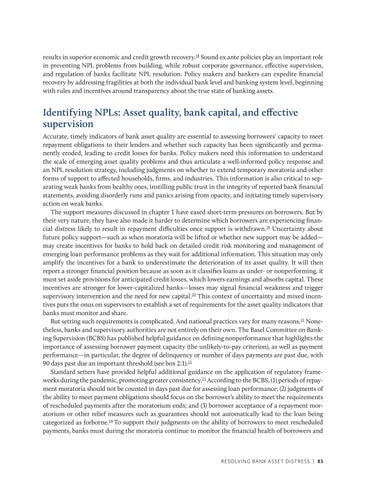results in superior economic and credit growth recovery.18 Sound ex ante policies play an important role in preventing NPL problems from building, while robust corporate governance, effective supervision, and regulation of banks facilitate NPL resolution. Policy makers and bankers can expedite financial recovery by addressing fragilities at both the individual bank level and banking system level, beginning with rules and incentives around transparency about the true state of banking assets.
Identifying NPLs: Asset quality, bank capital, and effective supervision Accurate, timely indicators of bank asset quality are essential to assessing borrowers’ capacity to meet repayment obligations to their lenders and whether such capacity has been significantly and permanently eroded, leading to credit losses for banks. Policy makers need this information to understand the scale of emerging asset quality problems and thus articulate a well-informed policy response and an NPL resolution strategy, including judgments on whether to extend temporary moratoria and other forms of support to affected households, firms, and industries. This information is also critical to separating weak banks from healthy ones, instilling public trust in the integrity of reported bank financial statements, avoiding disorderly runs and panics arising from opacity, and initiating timely supervisory action on weak banks. The support measures discussed in chapter 1 have eased short-term pressures on borrowers. But by their very nature, they have also made it harder to determine which borrowers are experiencing financial distress likely to result in repayment difficulties once support is withdrawn.19 Uncertainty about future policy support—such as when moratoria will be lifted or whether new support may be added— may c reate incentives for banks to hold back on detailed credit risk monitoring and management of emerging loan performance problems as they wait for additional information. This situation may only amplify the incentives for a bank to underestimate the deterioration of its asset quality. It will then report a stronger financial position because as soon as it classifies loans as under- or nonperforming, it must set aside provisions for anticipated credit losses, which lowers earnings and absorbs capital. These incentives are stronger for lower-capitalized banks—losses may signal financial weakness and trigger supervisory intervention and the need for new capital.20 This context of uncertainty and mixed incentives puts the onus on supervisors to establish a set of requirements for the asset quality indicators that banks must monitor and share. But setting such requirements is complicated. And national practices vary for many reasons.21 Nonetheless, banks and supervisory authorities are not entirely on their own. The Basel Committee on Banking Supervision (BCBS) has published helpful guidance on defining nonperformance that highlights the importance of assessing borrower payment capacity (the unlikely-to-pay criterion), as well as payment performance—in particular, the degree of delinquency or number of days payments are past due, with 90 days past due an important threshold (see box 2.1).22 Standard setters have provided helpful additional guidance on the application of regulatory frameworks during the pandemic, promoting greater consistency.23 According to the BCBS, (1) periods of repayment moratoria should not be counted in days past due for assessing loan performance; (2) judgments of the ability to meet payment obligations should focus on the borrower’s ability to meet the requirements of rescheduled payments after the moratorium ends; and (3) borrower acceptance of a repayment moratorium or other relief measures such as guarantees should not automatically lead to the loan being categorized as forborne.24 To support their judgments on the ability of borrowers to meet rescheduled payments, banks must during the moratoria continue to monitor the financial health of borrowers and
RESOLVING BANK ASSE T DISTRESS | 83

